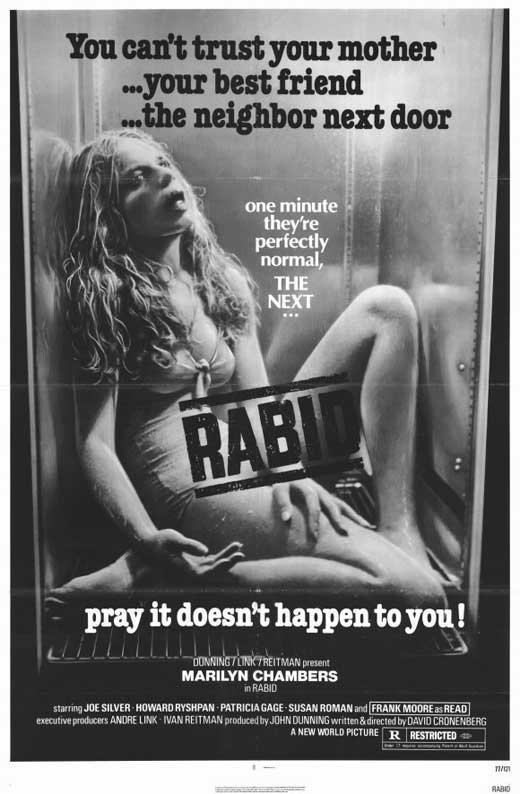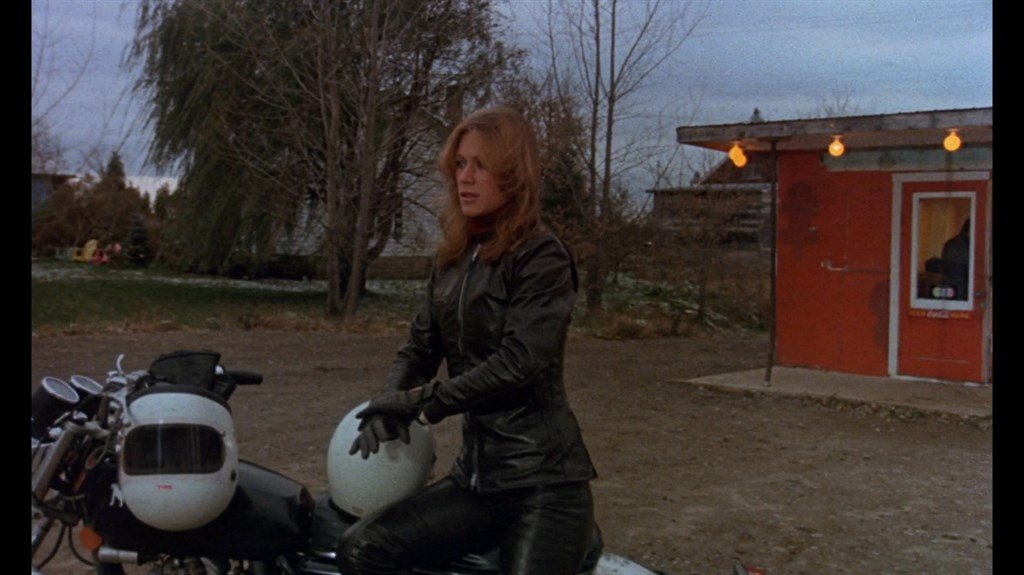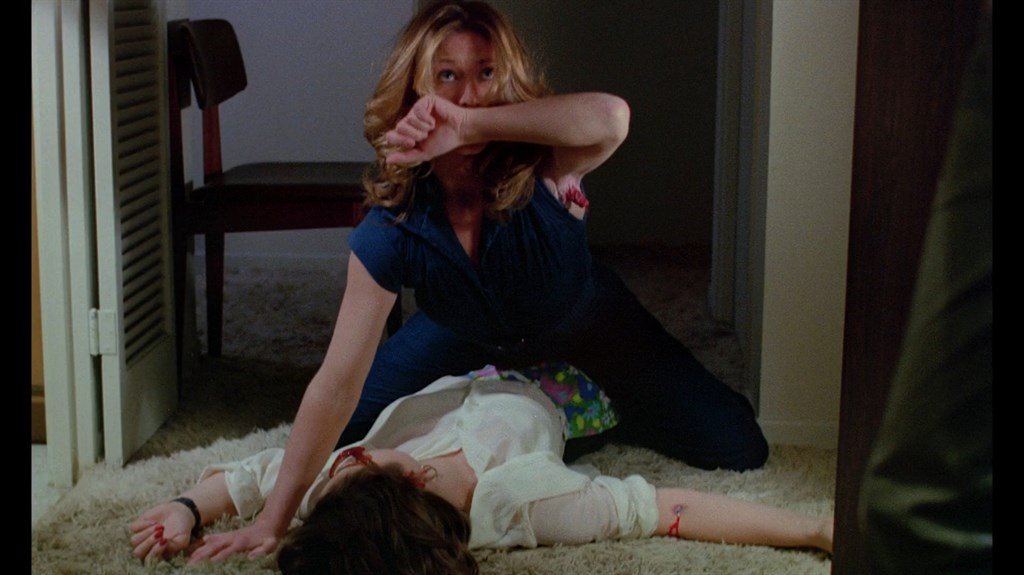RABID: The Cronenberg Contagion Spreads...
If your film debut is a shocking yet intelligent film like Shivers, what is the appropriate second act? David Cronenberg found the best possible answer when he made his next film, Rabid: it traffics in the same themes of sex and mutation while also showing he could add complexity and scope to his treatment of these concepts. The  result was a exploitation fan favorite that is also bursting with fascinatingly odd ideas and a perverse yet carefully controlled sense of artistry.Rabid begins with lovely Rose (erstwhile adult film star Marilyn Chambers) getting seriously injured when a motorcycle driven by her boyfriend Hart (Frank Moore) collides with a van. She is wheeled off to the nearest hospital, which happens to be a plastic surgery clinic run by the ambitious Dr. Keloid (Howard Ryshpan). He treats her disfiguring injuries with an experimental skin graft. Unfortunately, said treatment turns her into a vampire who develops a phallic proboscis under one arm that extracts blood from her victims. Even worse, any victims that survive develop a rabies-like homicidal madness that begins to spread with alarming speed.This storyline delivers all the shocks horror fans expect. Cronenberg's script uses Rose as a catalyst more than a classic lead character, allowing him to develop an episodic yet fast-moving plot packed with an interesting ensemble and plentiful horrific incidents. The film's final half-hour really pays off for the horror crowd, with nerve-jangling scenes like a rabid person attacking a passenger in a crowded subway car and a machine gun-toting cop trying to take down another rabies-mad attacker in a busy shopping mall.Conceptually, Rabid is an arresting fusion of vampire and zombie motifs, giving them an element of forward-thinking science as well a sexually subversive element (the casting of adult star Chambers adds to the latter). It also shows great imagination in its use of effective makeup effects from pioneering FX designer Joe Blasco. For instance, the barbed vampiric phallus that emerges from a vaginal orifice is a classic example of the flesh-distorting mutation that Cronenberg's early work is known for.
result was a exploitation fan favorite that is also bursting with fascinatingly odd ideas and a perverse yet carefully controlled sense of artistry.Rabid begins with lovely Rose (erstwhile adult film star Marilyn Chambers) getting seriously injured when a motorcycle driven by her boyfriend Hart (Frank Moore) collides with a van. She is wheeled off to the nearest hospital, which happens to be a plastic surgery clinic run by the ambitious Dr. Keloid (Howard Ryshpan). He treats her disfiguring injuries with an experimental skin graft. Unfortunately, said treatment turns her into a vampire who develops a phallic proboscis under one arm that extracts blood from her victims. Even worse, any victims that survive develop a rabies-like homicidal madness that begins to spread with alarming speed.This storyline delivers all the shocks horror fans expect. Cronenberg's script uses Rose as a catalyst more than a classic lead character, allowing him to develop an episodic yet fast-moving plot packed with an interesting ensemble and plentiful horrific incidents. The film's final half-hour really pays off for the horror crowd, with nerve-jangling scenes like a rabid person attacking a passenger in a crowded subway car and a machine gun-toting cop trying to take down another rabies-mad attacker in a busy shopping mall.Conceptually, Rabid is an arresting fusion of vampire and zombie motifs, giving them an element of forward-thinking science as well a sexually subversive element (the casting of adult star Chambers adds to the latter). It also shows great imagination in its use of effective makeup effects from pioneering FX designer Joe Blasco. For instance, the barbed vampiric phallus that emerges from a vaginal orifice is a classic example of the flesh-distorting mutation that Cronenberg's early work is known for. It's worst noting that Cronenberg's ideas are as unnerving as his special effects. A good example is how the position of Rose's vampiric organ requires her to hug her victims to bleed them dry. This turns a traditional gesture of affection into a harbinger of death - and puts the audience on the edge of their seat every time Rose embraces someone. The idea behind the experimental plastic surgery anticipates stem-cell research and the spreading of the contagion allows him to explore drug addiction and venereal disease metaphors as well as the horrors of martial law. That's a lot for an exploitation film to juggle but Cronenberg develops the ideas with skill and confidence.Similarly, Cronenberg shows a lot of skill behind the camera at this early juncture. Working with veteran Canadian cinematographer Rene Verzier, he gives the film a slick and controlled look that makes good use of naturalistic lighting to provide a believable backdrop for the horrific events. The scares are structured skillfully and he does an effective job of evoking large-scale chaos without having to show a lot. He also gets strong performances across the board: Chambers gives her all in a surprisingly natural performance that uses her physicality to convey her shift into vampirism while Moore does likeable low-key work as her frustrated boyfriend and Joe Silver lends nice support as a business partner at the clinic.
It's worst noting that Cronenberg's ideas are as unnerving as his special effects. A good example is how the position of Rose's vampiric organ requires her to hug her victims to bleed them dry. This turns a traditional gesture of affection into a harbinger of death - and puts the audience on the edge of their seat every time Rose embraces someone. The idea behind the experimental plastic surgery anticipates stem-cell research and the spreading of the contagion allows him to explore drug addiction and venereal disease metaphors as well as the horrors of martial law. That's a lot for an exploitation film to juggle but Cronenberg develops the ideas with skill and confidence.Similarly, Cronenberg shows a lot of skill behind the camera at this early juncture. Working with veteran Canadian cinematographer Rene Verzier, he gives the film a slick and controlled look that makes good use of naturalistic lighting to provide a believable backdrop for the horrific events. The scares are structured skillfully and he does an effective job of evoking large-scale chaos without having to show a lot. He also gets strong performances across the board: Chambers gives her all in a surprisingly natural performance that uses her physicality to convey her shift into vampirism while Moore does likeable low-key work as her frustrated boyfriend and Joe Silver lends nice support as a business partner at the clinic. In short, Rabid is a pivotal film in Cronenberg's career because it showed he could express a complex yet uniquely personalized vision in a way that could communicate with an audience. Any fan of his later work will enjoy watching the progression he makes from low-budget beginnings here.
In short, Rabid is a pivotal film in Cronenberg's career because it showed he could express a complex yet uniquely personalized vision in a way that could communicate with an audience. Any fan of his later work will enjoy watching the progression he makes from low-budget beginnings here.


